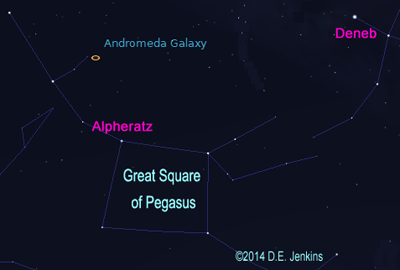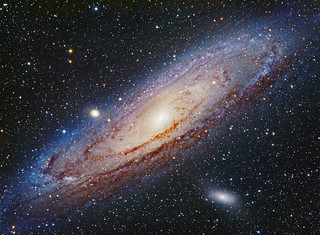
October 2014 - Vol. 18, No. 10
This Month's Night Sky - NOTE: The next paragraph describes the sky as it appears at 10 pm EST (11 pm EDT) near mid- month. The sky also looks this way at 11 pm EST (midnight EDT) during the beginning of the month and at 9 pm EST (10 pm EDT) by month's end.
Although the Summer Triangle is still visible in the W, the Square of Pegasus is now prominent high in the S. Far below, lonely Fomalhaut [FOE-ma-lot] of Piscis Austrinus still glitters near the S horizon. Between Pegasus and the N pole star, Polaris (Ursa Minor), find the familiar "W" shaped asterism of Cassiopeia. If you are fortunate to be viewing from a dark site, you will also see the constellations, Perseus and Auriga, with its bright star, Capella, embedded in a starry band stretching across the night sky from E to W. You are looking at the Milky Way, one of the spiral arms of our galaxy. In the E the constellations, Gemini, with its bright twin stars, Castor and Pollux, and Orion, with its distinctive hour glass asterism, rise above the E horizon. Now the Big Dipper (Ursa Major) dips low in the N. October 2014 offers a total lunar eclipse that will be visible from North America, South America and parts of Asia and Australia. Greatest eclipse will be centered over Hawaii. Observers in the eastern U.S. will have to observe totality in the early morning. The moon will still be eclipsed when it sets.
MERCURY vanishes from the evening sky as the planet approaces inferior conjunction on October 1. It reappears late in the month to the morning sky. VENUS disappers during superior conjunction until December when the planet returns to the evening sky. JUPITER rises in the morning sky, moving into the constellation of Leo this month. MARS moves into Sagittarius, passing by some of the brightest Milky Way objects and will be setting before mid-night. SATURN disappears in the western horizon this month, moving toward conjunction in November. URANUS will be at opposition on the 7th of October and can be observed all night.
Review how to determine Angular Measurement.
Calendar of Events
NOTE: For those observers not in the ET zone, convert the calendar times to your zone's time by subtracting one hour for CT, two for MT and three for PT. Don't forget to adjust for Daylight Savings Time when necessary by subtracting one hour from your planisphere's time. Dawn and dusk times must also be corrected. See your local newspaper, TV news, or cable TV's Weather Channel for sunrise and sunset times. Unfortunately some of these events may occur during daylight hours in your area.
| DATE | EVENT |
| 01 | Mars 4 deg S. of the Moon. |
| 06 | Moon at perigee. | 07 | Uranus at opposition. |
| 08 | Total lunar eclipse. Draconid meteors will be outshone by the moon, at least until the eclipse darknes the surface. This eclipse will be early morning for most observers, so there is a good chance of seeing some meteors during the eclipse. Also Uranus 1.2 deg S of Moon, an actual occultation from Asia, Greenland and the Arctic Ocean. |
| 12 | Aldeberan 1.4 deg S. of the Moon. |
| 16 | Mercury at inferior conjunction. |
| 18 | Jupiter 5 deg N. of Moon. The Moon will also reach apogee this day. |
| 20 | The Zodiacal Light or "false dawn" is visible in the E about 2 hours before sunrise. This pyramidal glow is caused by meteoroids, dust particles spawned by passing comets, etc., that have settled into the ecliptic plane (path followed by the Sun, Moon and planets), reflecting the Sun’s light before it rises here. This phenomenon will be visible through October. |
| 21 | Orionids meteor shower peak This shower can produce up to 20 meteors per hour at its peak. |
| 23 | Partial solar eclipse visible from Canada and Mexico. |
| 25 | Mercury at perihelion. Venus in superior conjunction. Saturn 1.0 deg S. of Moon, occultation from Canada, Greenland, eastern Europe. |
| 28 | Mars 7 deg S. of Moon. |
| 30 | Early morning risers with a good eastern horizon may catch Mercury approaching the first magnitude star, Spica in the constellation of Virgo. |
Lunar Almanac for October 2014
| Phases of the Moon | Phase and Date(s) | Best viewed before local midnight |
 |
New 23 |
Deep Space Objects |
 |
1st. Qtr 1 & 30 |
Planets & Moon |
 |
Full 8 |
Moon |
 |
Last Qtr 15 |
Deep Space & Planets |
Deep Sky Splendor: the Andromeda Galaxy
The fall sky is filled with the bright star clouds of the Milky Way running from the south western horizon toward the north east through the constellations of the Summer Triangle, that is now past the zenith for northern locations when the last gasp of twilight fades. Following the triangle, a Great Square formed by four fairly bright stars, one of them Alpheratz that really belongs to a neighboring constellation.. Galloping toward zenith, Pegasus, the flying horse carries with it the most distant galaxy that is easily visible by the naked eye.

Known as M31, or the Andromeda galaxy is the brightest object outside of the Milky Way that is easily visible with the naked eye. It is a whopping 2,538,000 light years away and still covers 3 degrees of the night sky. In contrast, the full moon only covers half a degree.
Andromeda is a spiral galaxy, 110,000 light years in diameter containing a trillion stars. It is a splendid object from a dark site. Field glasses will reveal a well-formed oval cloud, because the spirals tipped about 15 degrees toward the Earth rather than edge-on or facing. Even so, an amateur telescope can reveal its central nucleus and good images reveal the dark veins of its spiral arms. Classified as a Sb spiral, the galaxy’s central bulge is composed of yellow stars while blue stars are more concentrated in its arms.
Andromeda and the Milky Way galaxy, along with M-33 in Triangulum, are the largest members of our Local Group that is, a number of galaxies that are gravitationally bound. The Local Group is thought to contain about 30 members, most of these are dwarf galaxies like the Large and Small Magellanic Clouds visible from the southern hemisphere. The “Clouds” are dwarf galaxies that are tightly bound to the Milky Way. Andromeda also has a number of dwarf companions. Notably, NGC 205 and M32 are often visible on images with the main spiral. There are two more members of Andromeda’s family, NGC 185 and NGC147 that are located in the nearby constellation of Cassiopeia.
This image is a composite of images of the Andromeda galaxy and the two nearby companions that were taken by Terry Hancock in August of 2012 and edited to produce this beautiful result. Visit Terry's Down Under Observatory for great astrophotos that may be purchased. You may also like Terry's "Sagittarius Starscape" featured on theAstronomy Picture of the Day (APOD)site on September 5, 2014! Many thanks to Terry for sharing this astrophoto with readers of the What's up? almanac!
It is possible that Andromeda and Milky Way collided 10 billion years ago and it is also possible that they will collide again in another 4 billion years. Although this collision might mean the end of Milky Way and Andromeda, it may be that a new, larger elliptical galaxy will result. In any case, we can sit back and enjoy the sight of this massive, distant spiral from a deep sky site free from worry. Some night when the conditions are just right and the site is dark enough, you might catch a glimpse of a huge oval cloud that you'll never forget.
--See You Under the Stars!
Astra for Astra's Almanac
This installment of "Whats Up?" is ©2014 by Dawn Jenkins for Astra's Stargate. View Ron Leeseburg's Farewell Issue for information on where to find information such as is presented in this almanac.
